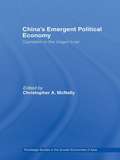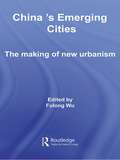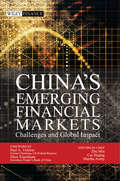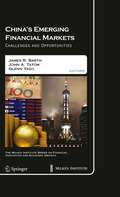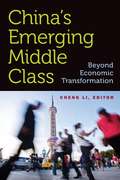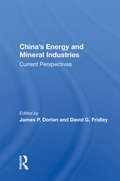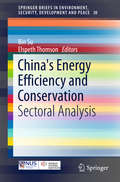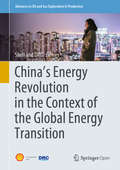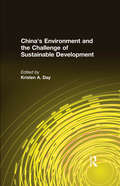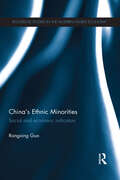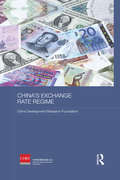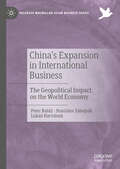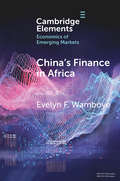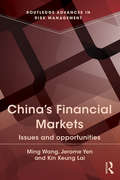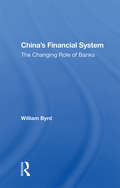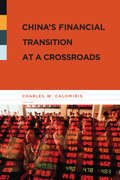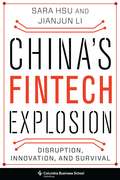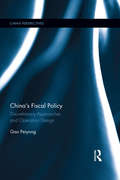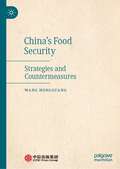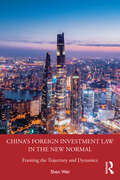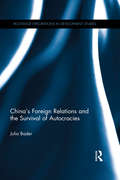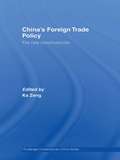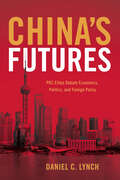- Table View
- List View
China's Emergent Political Economy: Capitalism in the Dragon's Lair (Routledge Studies in the Growth Economies of Asia #Vol. 75)
by Christopher A. McNallyThis edited volume represents the first collaborative effort to explicitly view China’s rapid international ascent as associated with the same process that catapulted Great Britain, the United States, Germany, and Japan to international prominence – the emergence of a capitalist political economy. Each chapter therefore applies the capitalist lens to analyze aspects of China’s monumental social, economic, and political transition. Topics addressed range from examinations of China’s industrial capitalism and its new multinational corporations to studies of China’s changing polity, state-media relations, and foreign policy. With contributors writing from highly varied backgrounds each chapter approaches the subject from a slightly different perspective, but the underlying findings show considerable common ground. China is developing a unique form of capitalism by combining elements rooted in Chinese history, such as the prevalence of networked forms of capital and the continued dominance of the state, with the growing influence of global capital, including the rapid adaptation of recent organizational and technological innovations. Concluding chapters draw out what capitalism in the dragon’s lair implies for our 21st century world, cautioning that China’s rise is likely to challenge the present world order along both political and economic dimensions.
China's Emerging Cities: The Making of New Urbanism (Routledge Contemporary China Series #Vol. 26)
by Fulong WuWith urbanism becoming the key driver of socio-economic change in China, this book provides much needed up-to-date material on Chinese urban development. Demonstrating how it transcends the centrally-planned model of economic growth, and assessing the extent to which it has gone beyond the common wisdom of Chinese ‘gradualism’, the book covers a wide range of important topics, including: local land development the local state private-public partnership foreign investment urbanization ageing home ownership. Providing a clear appraisal of recent trends in Chinese urbanism, this book puts forward important new conceptual resources to fill the gap between the outdated model of the ‘Third World’ city and the globalizing cities of the West.
China's Emerging Financial Markets
by Martha Avery Zhu Min Cai Jinqing"The 19th century belonged to England, the 20th century belonged to the US and the 21st century belongs to China. Invest accordingly. " Warren Buffet This comprehensive resource presents the views of China's most highly respected economists, bankers, and policy makers--along with opinions from Western authorities--on the current state of banking and finance in China. Tracing the history of China's banking and finance system and looking toward its future, the book offers valuable insight for financial service providers, bankers, private equity and hedge fund managers, and equity research and credit analysts. Contributors to the book includes: Jamie Dimon - Chairman & CEO, JPMorgan Chase BankGuo Shuqing - Chairman, China Construction BankPaul Volcker - Former Chairman, U. S. Federal ReserveStephen S. Roach - Chairman, Morgan Stanley AsiaWang Dongming - Chairman, CITIC Securities Co. , Ltd; and many more!
China's Emerging Financial Markets: Challenges and Opportunities (The Milken Institute Series on Financial Innovation and Economic Growth #8)
by James R. Barth John A. Tatom Glenn YagoWithin the past three decades China has undergone tremendous structural changes in its economy. The Editors discuss the recent and ongoing reforms in China's financial system and their role in the world economy. China's GDP has grown almost three times the world average; now only behind the United States, Japan and Germany. The focus of this book is to examine, in detail, China's changing financial system in order to assess whether it can catch up with, or even drive economic growth.
China's Emerging Middle Class: Beyond Economic Transformation
by Cheng LiThe rapid emergence and explosive growth of China's middle class have enormousconsequences for that nation's domestic future, for the global economy, and for the whole world. In China's Emerging Middle Class, noted scholar Cheng Li and a team of experts focus on the sociopolitical ramifications of the birth and growth of the Chinese middle class over the past two decades. The contributors, from diverse disciplines and different regions, examine the development and evolution of China's middle class from a variety of analyticalperspectives. What is its educational and occupational makeup? Are its members united by a common identity—by a shared political vision and worldview? How does the Chinese middle class compare with its counterparts in other countries? The contributors shed light on these and many other issues pertaining to the rapid rise of the middle class in the Middle Kingdom. Contributors: Jie Chen (Old Dominion University), Deborah Davis (Yale University),Bruce J. Dickson (George Washington University), Geoffrey Gertz (Brookings), HanSang-Jin (Seoul National University), Hsin-Huang Michael Hsiao (National TaiwanUniversity), Homi Kharas (Brookings), Li Chunling (Chinese Academy of Social Sciences),Jing Lin (University of MarylandCollege Park), Sida Liu (University of WisconsinMadison), Lu Hanlong (Shanghai Academy of Social Sciences), Joyce Yanyun Man(Peking UniversityLincoln Center), Ethan Michelson (Indiana UniversityBloomington),Qin Chen (Hohai University), Xiaoyan Sun (Beijing Foreign Studies University), LuigiTomba (Australian National University), Jianying Wang (Yale University), and ZhouXiaohong (Nanjing University).
China's Energy And Mineral Industries: Current Perspectives
by James P. Dorian David G. FridleyThis book is based on papers presented at the China Energy and Mineral Policies and Planning Conference held at the East-West Center. It discusses the energy and minerals development policies of China as well as the outlook for trade in technology, energy commodities, and minerals.
China's Energy Efficiency and Conservation: Sectoral Analysis (SpringerBriefs in Environment, Security, Development and Peace #30)
by Bin Su Elspeth ThomsonThis Brief identifies various aspects of energy challenges faced by the Chinese central/local governments, and also provides an opportunity to study how best to achieve green growth and a low-carbon transition in a developing country like China. The progress of China's carbon mitigation policies also has significant impacts on the on-going international climate change negotiations. Therefore, both policymakers and decision makers in China and other countries can benefit from studying the challenges and opportunities in China's energy development.
China's Energy Revolution in the Context of the Global Energy Transition (Advances in Oil and Gas Exploration & Production)
by Shell International B.V. The Development Research Center (DRC) of the State Council of the People’s Republic of ChinaThis open access book is an encyclopaedic analysis of the current and future energy system of the world’s most populous country and second biggest economy. What happens in China impacts the planet. In the past 40 years China has achieved one of the most remarkable economic growth rates in history. Its GDP has risen by a factor of 65, enabling 850,000 people to rise out of poverty. Growth on this scale comes with consequences. China is the world’s biggest consumer of primary energy and the world’s biggest emitter of CO2 emissions. Creating a prosperous and harmonious society that delivers economic growth and a high quality of life for all will require radical change in the energy sector, and a rewiring of the economy more widely. In China’s Energy Revolution in the Context of the Global Energy Transition, a team of researchers from the Development Research Center of the State Council of China and Shell International examine how China can revolutionise its supply and use of energy. They examine the entire energy system: coal, oil, gas, nuclear, renewables and new energies in production, conversion, distribution and consumption. They compare China with case studies and lessons learned in other countries. They ask which technology, policy and market mechanisms are required to support the change and they explore how international cooperation can smooth the way to an energy revolution in China and across the world. And, they create and compare scenarios on possible pathways to a future energy system that is low-carbon, affordable, secure and reliable.
China's Environment and the Challenge of Sustainable Development
by Kristen A. DayChina has been experiencing extraordinary economic growth for over two decades. Behind the remarkable statistics, however, it is facing a pressing issue: balancing its economic development needs with protecting its environmental resources. The environmental issue in China has a profound impact on the rest of the world as well, in such concerns as global warning and ethical and legal considerations about environmental enforcement. This book covers a broad range of topics, from specific environmental assessments in key sectors (i.e. desertification) to the policy implications of China's entry into the WTO. The contributors include scholars, government officials, business consultants, environmental science and technology experts, and others based in China and the United States. Sharing perspectives that reflect their diverse backgrounds, these experts offer valuable insights for handling the emerging opportunities and challenges of doing business in China.
China's Environmental Challenge
by William C. Kirby Erica M Zendell Brittany Crow Nora BynumChina faces enormous environmental challenges. This background note looks at the historical, economic and political origins of the environmental crisis that faces the world's fastest-growing economy.
China's Ethnic Minorities: Social and Economic Indicators
by Rongxing GuoThe majority of China’s population is the Han. Till now, China has officially identified, except for other unknown ethnic groups and foreigners with Chinese citizenship, 55 ethnic minorities. Ethnic minorities vary widely in size in China. With a population of more than 15 million, the Zhuang have been the largest minority group, and the Lhoba, with only 2 thousand or more, the smallest. China’s ethnic diversity has resulted in a special socioeconomic landscape of China itself. The book sets out to collect and estimate a full set of data on the socioeconomic situations of China’s ethnic minorities. Till present, a complete socioeconomic picture of China’s ethnic groups still remains unclear from China’s official sources. How different have been China’s ethnic minorities in every sphere of daily life and economic development during China’s fast transition period? In order to answer these questions, we need a detailed and comparable set of data for each of China’s ethnic minorities. This book provides, in an easy to use format, a broad collection of data on China’s 55 ethnic minorities. It is a resource book that profiles the demography, employment and wages, people’s livelihood, agriculture, industry, education, science and technology, and culture, sports and public health for each of these ethnic minorities. These indicators, estimated on the author based on materials gathered from a variety of sources and clearly presented in one volume, will be of great value to researchers, businesses, government agencies, and news media.
China's Exchange Rate Regime (Routledge Studies on the Chinese Economy)
by China Development Research FoundationThe imbalance between China’s currency, the RMB, and those of other countries is widely regarded as a major problem for the world economy. There was a reform of China’s exchange rate mechanism in 2005, following which the RMB appreciated 17% against the US dollar, but many people argue that further reform is still needed. This book reports on a major research project undertaken following the 2005 reform to assess the impact on China’s economy. It considers the impact in a number of areas of the economy, including export-oriented companies, the banking industry, international trade, international capital flows, and China’s macroeconomic policy. It concludes that the policies pursued so far have been correct, and that further reform, both to the exchange rate, and to the system overall, would be desirable, but that any reform should be gradual and incremental, preserving economic stability, and integrating changes with reform in other parts of the economy.
China's Expansion in International Business: The Geopolitical Impact on the World Economy (Palgrave Macmillan Asian Business Series)
by Peter Baláž Stanislav Zábojník Lukáš HarvánekCapturing the overall development of the Chinese economy, this comprehensive book offers an introduction to one of the most astonishing economic growth stories of the last three decades. The authors identify the key stages and unique features of China’s development, exploring its geopolitical impact on the world economy, and in particular, on the European Union. Analysing factors such as education, urbanisation and innovation, this book highlights the reasons behind China’s success in the international market, and places a special focus on the country’s energy policy. By providing insights into such an important case of expansion and growth in international business, this innovative book will be of interest to those researching Asian business, internationalisation and the Chinese economy.
China's Finance in Africa: What and How Much? (Elements in the Economics of Emerging Markets)
by Evelyn F. WamboyeThis Element provides a detailed analysis of official finances from China to Africa with special attention to the question of Africa's foreign finances policy. The findings reveal that Africa has an infrastructure gap and Chinese finances are largely used to fund infrastructure projects. However, the majority of the funds are loans, which are mortgaged on Africa's natural resources. In addition, Chinese firms are the ones implementing the projects, and much of the raw material and labor is imported from China. All these calls for Africa to institute a coherent foreign finances policy that ensures African countries fully benefit from these finances.
China's Financial Markets: 2006
by F. Warren Mcfarlan Li Jin Tracy Yuen MantyProvides an overview of capital markets in mainland China, evaluating the up-to-date performance of key components of the markets, highlighting concerns as China strives to modernize its financial system to meet global competition and support its fast growing economy.
China's Financial Markets: Issues and Opportunities (Routledge Advances in Risk Management)
by Ming Wang Kin Keung Lai Jerome YenThis book provides an overview of China’s financial markets and their latest developments. The book explores and discusses the difficulties in building modern financial markets that are compatible with an increasingly complicated market economy and examines the various strategies to reform China’s financial system. It covers a range of topics: China’s financial structure, financial regulation, financial repression and liberalization, monetary policy and the People's Bank of China, banking reforms, exchange rate policy, capital control and capital-account liberalization, and development of the stock markets. The book provides a basic understanding of the current issues related to the development of China’s financial markets. It enhances knowledge of China’s regulatory framework which has helped to shape China’s financial landscape. It provides specific, useful knowledge about investment in China, such as, market sense, to identify the investment opportunities in various asset classes.
China's Financial System: The Changing Role Of Banks
by William ByrdStrengthening the banking system and expanding its role in resource mobilization and allocation have been key components of recent economic reform policies in the People's Republic of China. This study of China's financial system focuses on new policies and reforms undertaken since 1976, including institutional restoration, proliferation, and decen
China's Financial Transition at a Crossroads
by Charles CalomirisChina's increasing role in global economic affairs has placed the country at a crossroads: how many and what types of international capital-market transactions will China permit? How will China's financial system change internally? What kind of relationships will the Chinese government develop with foreign financial institutions, especially with those based in the United States? Can China broker a sustainable partnership with America that will avoid sending economic shock waves throughout the world?Drawing on the contemporary research of prominent international scholars, the experts in this volume outline the trajectory of China's financial markets since the advent of reform and anticipate their uncertain future. Chapter authors and commentators include Geert Bekaert, Loren Brandt, Lee Branstetter, Mary Wadsworth Darby, Michael DeStefano, Barry Eichengreen, Campbell Harvey, Fred Hu, Xiaobo Lu, Christian Lundblad, Ailsa Roell, Daniel Rosen, Shang-Jin Wei, Jialin Yu, and Xiaodong Zhu. The book begins with an overview of the history of financial-sector development, regulation, and performance and then focuses on the banking sector, discussing the progress, challenges, and prospects of current sector reform. Subsequent chapters describe the role of foreign capital in China's development and analyze the changes in capital flows and controls over time; explore various explanations for China's composition of foreign-capital and foreign-exchange policies, particularly the factors shaping China's reliance on foreign direct investment; and provide an international, comparative perspective on the remarkable growth experience of China and the contribution of its institutional environment to that experience. Contributors dispute the belief that stock market listing has done little to reform state-owned enterprises and take a hard look at the exchange rate regime choice for China, considering the potential long-run desirability of flexibility and the appropriate sequencing of reforms in foreign-exchange policy, domestic banking reform, and capital-market openness. The book concludes with a roundtable discussion in which prominent economists, including Peter Garber, Robert Hodrick, John Makin, David Malpass, Frederic Mishkin, and Eswar Prasad, debate the pace of the appreciation of China's currency and the likely consequences of that policy within and outside of China.
China's Fintech Explosion: Disruption, Innovation, and Survival
by Jianjun Li Sara HsuFinancial technology—or fintech—is gaining in popularity globally as a way of making financial services more efficient and accessible. In rapidly developing China, fintech is taking off, catering to markets that state-owned banks and an undersized financial sector do not serve amid a backdrop of growing consumption and a large, tech-savvy millennial generation. It is becoming increasingly likely that some of China’s fintech firms will change the way the world does business.In China’s Fintech Explosion, Sara Hsu and Jianjun Li explore the transformative potential of China’s financial-technology industry, describing the risks and rewards for participants as well as the impact on consumers. They cover fintech’s many subsectors, such as digital payment systems, peer-to-peer lending and crowdfunding, credit card issuance, internet banks, blockchain finance and virtual currencies, and online insurance. The book highlights the disruption of traditional banking as well as the risks of fintech and regulatory technology. Hsu and Li describe major companies including Alipay and Tencent, developer of WeChat Pay and a wealth-management business, and other leading fintech firms such as Creditease, Zhong An Insurance, and JD Finance. Offering expert analysis of market potential, risks, and competition, as well as case studies of firms and consumer behavior, China’s Fintech Explosion is a must-read for anyone interested in one of the world’s breakout sectors.
China's Fiscal Policy: Discretionary Approaches and Operation Design (China Perspectives)
by Gao PeiyongAs an important macroeconomic variant, the fiscal revenue and expenditure can influence the operation of the whole economic and social activities by changing the existing GDP distribution pattern, affecting the consumption and investment of enterprises and people, etc. Thus, fiscal policy has always been a primary instrument of macroeconomic regulation. This book imports fiscal policy into the framework of macroeconomic analysis and through the analysis of the former, it unfolds the major changes of China's macroeconomic operation in the past 20 years. This book begins with China's rejoining the General Agreement on Tariffs and Trade (GATT) in the 1990s which enabled China to deepen the reform and join the international market finally. It elaborates on the challenges China's taxation would be confronted with after rejoining the GATT, including the decrease of tax revenue and higher requirements for tax reform. Then this book combs China's fiscal policies under various economic situations chronologically–tax policy under the background of deflation, proactive fiscal policy at the beginning of 21st century, macroeconomic policy options facing a complicated and volatile economy, etc. How to deal with the ¡°new normal¡± of development China's economy has entered is also addressed. This book will appeal to scholars and students of economics and China's economic studies.
China's Food Security: Strategies and Countermeasures
by Wang HongguangThis book makes a systematic study of the history, current situation and trend of China's food security and the global food security. COVID-19 has triggered a world food crisis. Understanding the history, current situation and trend of China's and global food security is conducive to the rational arrangement of agricultural production, food storage, scheduling and import by management departments; it is conducive to the understanding of the situation of food supply and demand; it is conducive to the rational arrangement of production and operation planning. This book systematically studies the history and experience of China's food security, analyzes the 9 major problems facing the current food security, calculates the potential food production, puts forward the strategies and countermeasures for food security in the next 20 years and puts forward 4 strategies and 8 countermeasures for ensuring food security. This book will be of great value to scholars of international relations and sinologists, and has special relevance to United Nations sustainable development goal 2, eliminating hunger.
China's Foreign Investment Law in the New Normal: Framing the Trajectory and Dynamics
by Shen WeiThis book analyzes China's foreign investment law which came into force in January 2020. The new law implemented sweeping changes and overhauled China’s foreign investment law regime of the last four decades. The foreign investment law aims to make the business environment more investor-friendly and address some of the contentious issues between US and China in the ongoing trade war. The book explains how the law enhances regulatory transparency. It also outlines the new approval process, that is the pre-establishment negative list system which has replaced the former approval system for foreign investment projects. This book will help give readers a better understanding of major changes and benefits under the new law and will be the first of its kind looking at the implications of this law.
China's Foreign Relations and the Survival of Autocracies (Routledge Explorations in Development Studies)
by Julia BaderThe Chinese government has frequently been criticized for propping up anti-democratic governments. This book investigates the rise of China as an emerging authoritarian power. By comparing China’s bilateral relations to three Asian developing countries – Burma, Cambodia and Mongolia – it examines how China targets specific groups of actors in autocracies versus non-autocracies. It illustrates how the Chinese non-interference policy translates into support for incumbent leaders in autocratic countries and how the Chinese government has thereby profited from exploiting secretive decision making in autocracies to realize its own external interests such as achieving access to natural resources. In a statistical analysis of the patterns of Chinese external cooperation and their impact on the survival of autocratic leaders, the book finds some evidence that China is more likely to target autocracies with economic cooperation. However, only some forms of bilateral interaction are found to increase the prospect of survival for autocratic leaders. This important contribution to the understanding of both external factors of authoritarian endurance and China’s foreign relations, a field of study still lacking systematic investigation, will be of great interest to students and researchers in Development Studies, Asian Studies, International Relations, and International Political Economy.
China's Foreign Trade Policy: The New Constituencies (Routledge Contemporary China Series)
by Ka ZengChina’s rise as a major trading power has prompted debate about the nature of that country’s involvement in the liberal international economic order. China’s Foreign Trade Policy sheds light on this complex question by examining the changing domestic forces shaping China’s foreign trade relations. Specifically, this book explores the evolving trade policymaking process in China by looking at: China’s WTO accession negotiation China’s bilateral trade disputes The development of China’s antidumping regime China’s emerging trade disputes in the WTO. In addition, Ka Zeng examines how lobbying patterns in China are becoming more open and pluralistic, with bureaucratic agencies, sectoral interests, regional interests, and even transnational actors increasingly able to influence the process and outcome of China’s trade negotiations. Using case studies of China’s trade disputes with its major trading partners, as well as China’s participation in the dispute settlement process of the World Trade Organization, to present an in-depth analysis of China’s trade relations, this book will appeal to students and scholars of international political economy, Chinese politics and foreign policy, and more generally Asian studies.
China's Futures: PRC Elites Debates Economics, Politics, and Foreign Policy
by Daniel C. LynchChina's Futures cuts through the sometimes confounding and unfounded speculation of international pundits and commentators to provide readers with an important yet overlooked set of complex views concerning China's future: views originating within China itself. Daniel Lynch seeks to answer the simple but rarely asked question: how do China's own leaders and other elite figures assess their country's future? Many Western social scientists, business leaders, journalists, technocrats, analysts, and policymakers convey confident predictions about the future of China's rise. Every day, the business, political, and even entertainment news is filled with stories and commentary not only on what is happening in China now, but also what Western experts confidently think will happen in the future. Typically missing from these accounts is how people of power and influence in China itself imagine their country's developmental course. Yet the assessments of elites in a still super-authoritarian country like China should make a critical difference in what the national trajectory eventually becomes. In China's Futures, Lynch traces the varying possible national trajectories based on how China's own specialists are evaluating their country's current course, and his book is the first to assess the strengths and weaknesses of "predictioneering" in Western social science as applied to China. It does so by examining Chinese debates in five critical issue-areas concerning China's trajectory: the economy, domestic political processes and institutions, communication and the Internet (arrival of the "network society"), foreign policy strategy, and international soft-power (cultural) competition.
